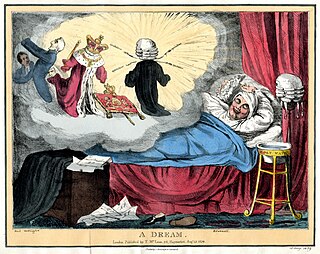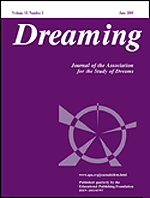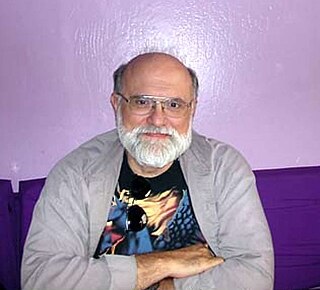In the psychology subfield of oneirology, a lucid dream is a type of dream wherein the dreamer realizes that they are dreaming during their dream. The capacity to have lucid dreams is a trainable cognitive skill. During a lucid dream, the dreamer may gain some amount of volitional control over the dream characters, narrative, or environment, although this control of dream content is not the salient feature of lucid dreaming. An important distinction is that lucid dreaming is a distinct type of dream from other types of dreams such as prelucid dreams and vivid dreams, although prelucid dreams are a precursor to lucid dreams, and lucid dreams are often accompanied with enhanced dream vividness. Lucid dreams are also distinct state from other lucid boundary sleep states such as lucid hypnagogia or lucid hypnopompia.

The American Psychological Association (APA) is the main professional organization of psychologists in the United States, and the largest psychological association in the world. It has over 157,000 members, including scientists, educators, clinicians, consultants, and students. It has 54 divisions, which function as interest groups for different subspecialties of psychology or topical areas. The APA has an annual budget of around $125 million.

A dream is a succession of images, ideas, emotions, and sensations that usually occur involuntarily in the mind during certain stages of sleep. Humans spend about two hours dreaming per night, and each dream lasts around 5–20 minutes, although the dreamer may perceive the dream as being much longer than this.
Oneiromancy is a form of divination based upon dreams, and also uses dreams to predict the future. Oneirogen plants may also be used to produce or enhance dream-like states of consciousness. Occasionally, the dreamer feels as if they are transported to another time or place, and this is offered as evidence they are in fact providing divine information upon their return.

Arnold Mindell was an American author, therapist, and teacher in the fields of transpersonal psychology, body psychotherapy, social change, and spirituality. He is known for extending Jungian dream analysis to body symptoms, promoting ideas of 'deep democracy,' and interpreting concepts from physics and mathematics in psychological terms. Mindell is the founder of process oriented psychology, or process work, a development of Jungian psychology influenced by Taoism, shamanism, and physics.

In the field of psychology, the subfield of oneirology is the scientific study of dreams. Research seeks correlations between dreaming and knowledge about the functions of the brain, as well as an understanding of how the brain works during dreaming as pertains to memory formation and mental disorders. The study of oneirology can be distinguished from dream interpretation in that the aim is to quantitatively study the process of dreams instead of analyzing the meaning behind them.
Dreamwork is the exploration of the images and emotions that a dream presents and evokes. It differs from classical dream interpretation in that it does not attempt to establish a unique meaning for the dream. In this way the dream remains "alive" whereas if it has been assigned a specific meaning, it is "finished". Dreamworkers take the position that a dream may have a variety of meanings depending on the levels that are being explored.

Paul Tholey was a German Gestalt psychologist, and a professor of psychology and sports science at the University of Frankfurt and the Technical University of Braunschweig.

Robert Moss is a historian, journalist, author and creator of a dreamwork technique called "active dreaming".
Deirdre Barrett is an American author and psychologist known for her research on dreams, hypnosis and imagery, and has written on evolutionary psychology. Barrett is a teacher at Harvard Medical School, and a past president of the International Association for the Study of Dreams (IASD) and of the American Psychological Association’s Div. 30, the Society for Psychological Hypnosis. She is editor-in-chief of the journal Dreaming: The Journal of the Association for the Study of Dreams and a consulting editor for Imagination, Cognition, and Personality and The International Journal for Clinical and Experimental Hypnosis.
Stephen LaBerge is an American psychophysiologist specializing in the scientific study of lucid dreaming. In 1967 he received his bachelor's degree in mathematics. He began researching lucid dreaming for his Ph.D. in psychophysiology at Stanford University, which he received in 1980. He developed techniques to enable himself and other researchers to enter a lucid dream state at will, most notably the MILD technique, which was used in many forms of dream experimentation. In 1987, he founded The Lucidity Institute, an organization that promotes research into lucid dreaming, as well as running courses for the general public on how to achieve a lucid dream.
Oneironautics refers to the ability to travel within a dream on a conscious basis. Such a traveler in a dream may be called an oneironaut.
Wynn R. Schwartz is an American clinical and experimental psychologist, research psychoanalyst, best known for his work on the Person Concept and his contributions to Descriptive psychology.
Patricia L. Garfield was an American academic specializing in the study of dreams, specifically the cognitive processes underpinning them. She was the author of 10 books covering a broad range of dream topics. These topics include: nightmares, children’s dreams, healing through dreams and dream-related art. Her best-known work is “Creative Dreaming.” Originally published in 1974 it was revised and reprinted again in 1995. She holds a Ph.D in psychology from Temple University.

Dreaming is a peer-reviewed academic journal published by the American Psychological Association on behalf of the International Association for the Study of Dreams. IASD's other peer-reviewed publication, the International Journal of Dream Research (IJoDR) is published on Heidelberg University Library servers.
Gerald Paul Koocher is an American psychologist and past president of the American Psychological Association (APA). His interests include ethics, clinical child psychology and the study of scientific misconduct. He is Dean Emeritus Simmons University and also holds an academic appointment at Harvard Medical School. Koocher has over 350 publications including 18 books and has edited three scholarly journals including Ethics & Behavior which he founded. The APA's Hoffman Report implicated Koocher for his role in creating memos to justify sexual, physical and emotional abuse of prisoners.
Suzanne Bennett Johnson is an American psychologist and a past president of the American Psychological Association (APA).

Mark Blagrove is a British research psychologist who specializes in the study of sleep and dreams.
Kelly Bulkeley is an American author and researcher in the fields of dreams and the psychology of religion.

Rev. Jeremy Taylor, DMin, was an American dream worker, author and Unitarian Universalist minister. He was a co-founder and past president of the International Association for the Study of Dreams.








